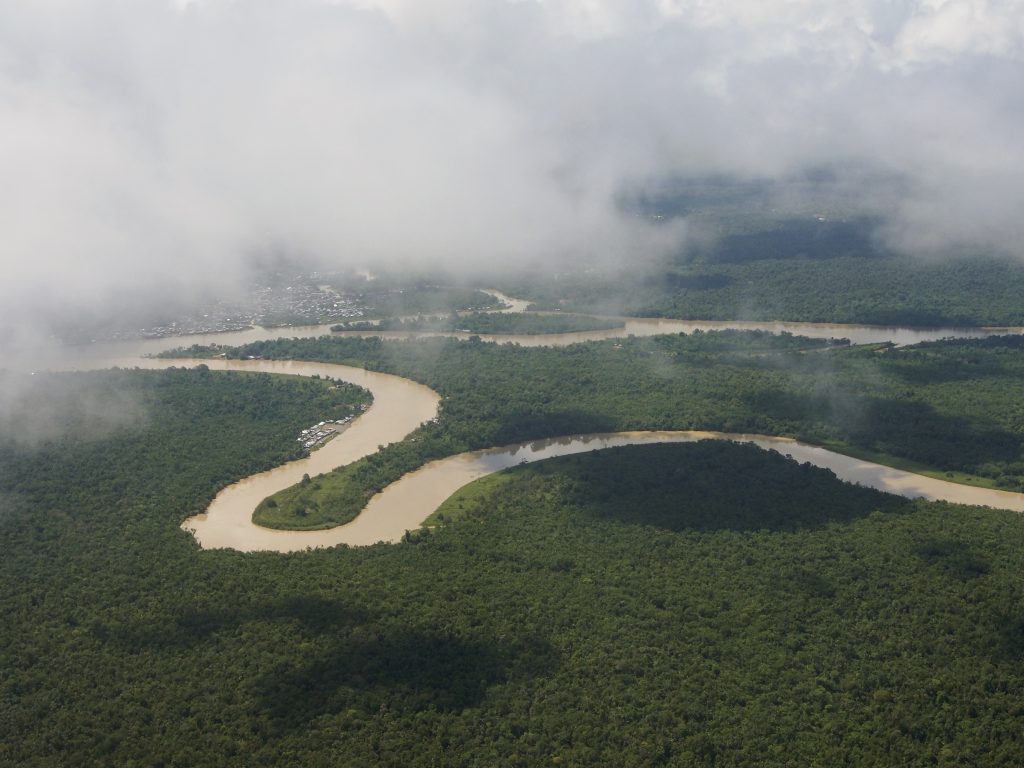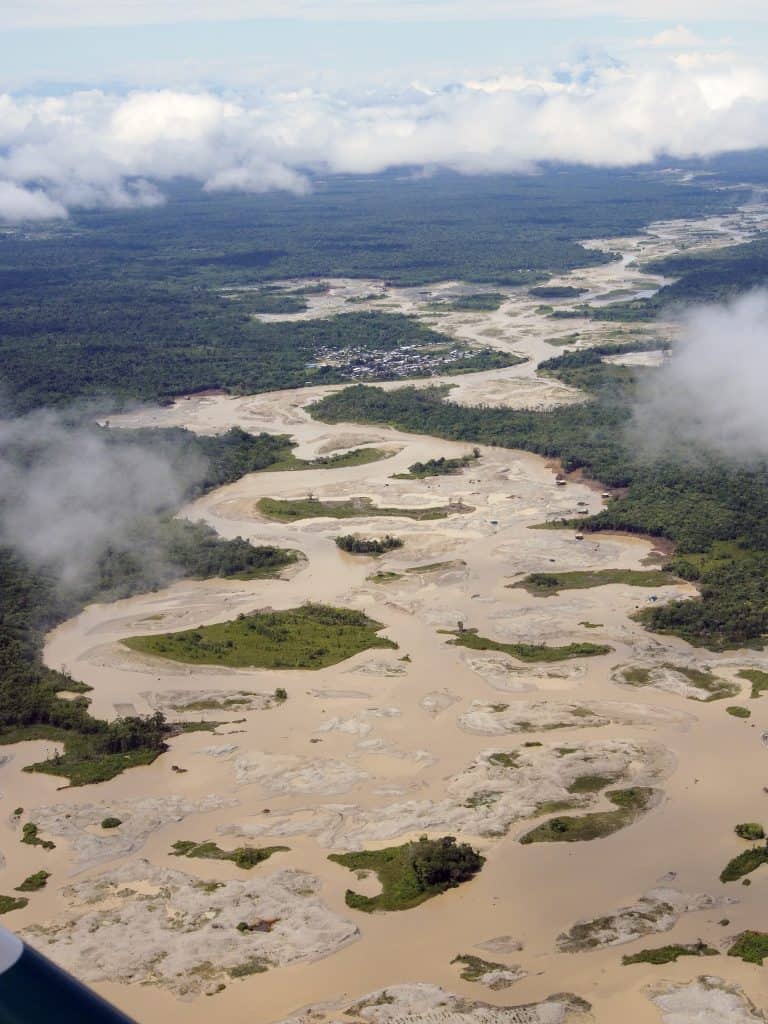
Rights of the River Atrato in Choco, Awarded by the Constitutional Court.
The Atrato River in the Chocó Biogeographic region is one of 25 global priority areas (hotspots) for biodiversity conservation. In 2016, the Colombian Constitutional Court issued ruling T-622, declaring the Atrato River a subject of rights, and issued orders aimed at protecting its ecosystems and the fundamental rights of the communities living along its banks. The Atrato river and its tributaries are the main resource for the local population – as a means of transport, for fishing, for bathing, washing clothes, employment, and enjoyment.
Chocó’s richness in mineral resources and its remoteness has advantages for the climate. The downside is the violence perpetrated by illegal armed and criminal organisations, as they fight for control over illicit economies and territory. Illegal gold mining is severely damaging people’s lives, ripping apart the social fabric, exploiting women and children, undermining governance, and driving local corruption. Furthermore, the use of toxic substances such as mercury and cyanide to separate out the gold, which is then washed into the river, causes contamination of the water and the fish as well as health problems. This combined with the lack of state presence and services has generated a humanitarian crisis for Choco. This crisis has been further exacerbated by the realities of the armed conflict.
The Constitutional Court in the T-622 decision issued a series of orders, firstly, to the Environment Ministry to develop an Environmental Action Plan; secondly, to the Ministry of Defence, to dismantle the illegal gold mining and thirdly to address to undertake a health study to examine the levels of toxicity in the blood of the local communities as a result of the mercury contamination and devise a plan to address these (a summary of the orders can be found here)
At the same time the Court created a legal entity known today as the Guardians of the Atrato River (which includes the Colombian Minister of the Environment and 14 community representatives from the Afro-Colombian and Indigenous Communities living along the banks of the River Atrato. The Constitutional Court created this body to oversee the implementation of the T-622 Court decision). The Guardians are supported in this work by the NGO Siembra
Nine years after this historic decision the Guardians have achieved some important successes. The Government has an Environmental Action Plan with funding allocated for its implementation. This success was due to the tireless work of the Guardians. Their insistence, participation, consultation and incorporation of the proposals made by them in the Environmental Action Plan was a major achievement. The key now is the implementation. It is essential that the Guardians remain at the heart of the decision making in respect to the implementation of the Environmental Action Plan. In addition to this a Health Study was ordered by the Government.
Colombian Defence Ministry
Unlike the Environmental Action Plan, which was drawn up in consultation with the indigenous and Afro-Colombian Communities and their representatives, the Guardians of the Atrato River, the Ministry of Defence’s Action Plan to dismantle illegal gold mining, was adopted without consultation. In fact, since the Court ruling in 2016, illegal gold mining backed by armed groups has expanded 47 km along the tributaries of the Atrato River, moving ever closer to Quibdó, demonstrating the Action Plan’s ineffectiveness.
Many of the problems that gave rise to the ruling in relation to illegal gold mining are still present, seriously affecting the ecosystem’s integrity of the watershed, as well as the lives of the communities that live along the Atrato River. Record-high international prices for gold, over the last five years, have spurred a rush in Chocó’s southern mining regions. Unlike other illegal economies, illegal gold mining happens in plain sight, about 15 minutes by boat from Quibdó, the departmental capital of Chocó.
The Guardians of the Atrato (Guardians) and others have been calling for a revision of the Action Plan to combat illegal gold mining, highlighting that a purely military plan will not effectively address the situation. Rather, the plan should be revised and expanded to adopt, a cross departmental Action Plan that incorporates the Unit of Financial Information and Analysis (UIAF) [1], located in the Ministry of Finance, to track the financial flows of illegal gold mining; the Public Prosecutors Office; and the DIAN (it records sales of gold). The Financial Analysis Unit is responsible for gold regulation and gold financial flows – cross departmental collaboration needs to be initiated from the Presidential Office and led by the Ministry of Defence. As the Court ordered, the Ministry of Defence to design the Action Plan to end illegal gold mining in the River Atrato.
It is essential that the Ministry of Defence consults with the Guardians of the Atrato River and the NGO Siembra and together with them and the Unit of Financial Information and Analysis, the DIAN, and the Public Prosecutors office, plan and execute a reformulated plan. This is the moment to address this as there are plans by the Defence Ministry to improve the Action Plan. International offers of help on the side of financial flows are essential as these are transnational.There is a responsibility by the UK and Europe, as this is where the gold is traded.
Illegal gold extraction by armed groups in Choco is estimated at U$300 million annually. Money obtained from selling the gold, strengthens the illegal armed groups, exacerbates the conflict, destroys important ecosystems in Chocó (and other areas with the same pattern, like the Amazon), it funds corruption of local authority personnel as well as the Security Forces locally, and makes it harder to build peace in these regions. Furthermore, illegal gold is used to launder drugs money and buy arms.
Colombia needs a national approach and regional cooperation when addressing illegal gold mining. This is because similar patterns in illegal gold mining are repeated across the Andean Region and in Brazil – violence, environmental destruction, human rights violations, corruption of local authorities, illicit gold flows into Europe, and the laundering of drugs money. To tackle this situation requires the identification and analysis of transnational financial flows, changes in policy in relation to the registration and sale of gold in Colombia, and policy changes to tightening of European gold regulations and supply chain.

- Ministry of Health – health strategy needed for dealing with health impacts of mercury in Choco
Exposure to mercury, even in small amounts, can cause serious health issues. In Chocó, mercury levels are not regularly monitored. The 2018 National Water Study[ii] estimated that there were 183 metric tons of mercury dumped into Colombia’s waterways. According to the United Nations Office on Drugs and Crime (UNODC)[iii], between 2017 and 2022, 37.9 tons of gold were officially recorded in Chocó (the total is likely much higher). For each gram of gold produced, approximately between 7 to 30 grams of mercury is used, meaning that nearly 265 tons of mercury were used only for the gold reported in the last five years.
The State commissioned a toxic study by the Cordoba University, completed in 2018, but the results have not been released. The reason for this is that the Colombian Government considers that the Health Study presented is not robust enough, but the University maintains that it has been done properly. There is therefore an impasse. For the people of Chocó it is essential to initiate a health strategy and to begin to address health issues related to high levels of heavy metals in the blood. At one time the Government talked about sending in Health Brigades specially trained in heavy metal toxicity, but this has not happened. A way forward would be to initiate a long-term health study, as the considerable increase in the last five years of the illicit gold mining means that the 2018 study is outdated. And at the same time initiate the implementation of a short-term health plan for those identified by the 2018 study as having absorbed mercury, and labelling the areas identified as highly contaminated. The idea of Health Brigades is also an important interim measure.
Recommendations to the UK Government and the Republic of Ireland
- to support the implementation of the T-622 Constitutional Court decision to end illegal gold mining in the Atrato River; and to offer expert help and resources to track financial flows;
- to highlight to the Colombian Government the importance of coordination across the departments of the Ministry of Defence, the Unit of Financial Information and Analysis, the DIAN, and the Public Prosecutor’s office in the planning and execution of a reformulated plan;
- To raise with the Colombian Government the need to implement a Heath Strategy, in line with the T-622 decision for those who have absorbed the mercury;
- To fund the work of the River Guardians as part of their efforts to address climate change and preserve biodiversity.
[1] The Unit of Financial Information and Analysis (UIAF) is responsible for receiving, analysing, and disseminating information on suspicious financial transactions to relevant authorities. The UIAF operates under the Ministry of Finance and Public Credit and is a key player in Colombia’s efforts to strengthen its anti-money laundering and counter-terrorism financing framework.
[ii] Estudio Nacional del Agua 2018 https://tinyurl.com/yrxakud7
[iii] UNODC, Colombia explotación de oro de aluvión EVOA 2022
